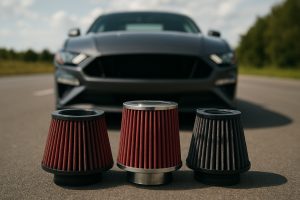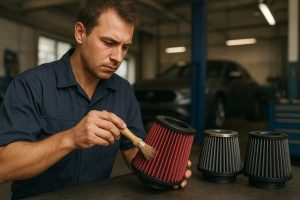When it comes to aftermarket modifications, few upgrades are as popular — or as debated — as performance air filters. Marketed as a quick and affordable way to boost horsepower, torque, and fuel efficiency, these filters are often one of the first upgrades car enthusiasts consider. But do they really deliver measurable performance gains, or is it more marketing hype than reality?
In this article, we’ll explore the science behind performance filters, their advantages and drawbacks, and whether they’re a worthwhile investment for everyday drivers. If you’re considering replacing your filter, you can easily buy Filters online to compare both standard and performance options.
What Are Performance Filters?

Performance filters are designed to allow a greater volume of air to flow into the engine compared to standard paper filters. Since combustion relies on a precise mix of air and fuel, more air theoretically allows for more efficient combustion, leading to improved horsepower.
Unlike disposable paper filters, most performance filters are made of oiled cotton, foam, or synthetic mesh. They are often reusable and require periodic cleaning instead of full replacement.
The Science: How Air Affects Horsepower
Engines are essentially air pumps — more air intake equals more oxygen, which can create a stronger combustion cycle. This principle is why performance filters claim to boost horsepower. However, the gain depends heavily on the engine design and how restrictive the factory air intake is.
| Factor | Impact on Performance |
|---|---|
| Airflow | Increased airflow may slightly improve horsepower (1–5 hp). |
| Filtration quality | Poor filtration can let harmful particles enter, reducing engine life. |
| Engine tuning | Gains are more noticeable in tuned or turbocharged engines. |
| Driving style | Performance filters help most at high RPMs, not during everyday commuting. |
Advantages of Performance Filters
-
Reusable design – Can be cleaned and reused for years, reducing waste.
-
Potential horsepower gain – Some vehicles see small but measurable increases (1–5 hp).
-
Better throttle response – Improved airflow can make acceleration feel sharper.
-
Enhanced engine sound – Often produces a deeper intake growl, appealing to enthusiasts.
-
Long-term savings – Higher initial cost, but cheaper over time since they are not replaced as often as paper filters.
Challenges and Drawbacks
While performance filters offer advantages, they are not without issues:
-
Minimal horsepower gains – In most stock vehicles, increases are modest and hardly noticeable.
-
Maintenance required – Oiled filters need cleaning and re-oiling, which can be messy.
-
Potential engine damage – Over-oiling can foul the mass airflow (MAF) sensor, leading to performance problems.
-
Higher cost upfront – More expensive than standard disposable filters.
-
Warranty concerns – Some manufacturers may void warranties if improper filters are used.
Real-World Performance Gains
Dyno Test Examples
| Vehicle Type | Stock HP | Gain with Performance Filter | Notes |
|---|---|---|---|
| Compact hatchback | 120 hp | +1–2 hp | Minimal improvement, barely noticeable. |
| Mid-size sedan | 180 hp | +3–4 hp | Slightly sharper throttle response. |
| Turbocharged SUV | 250 hp | +5–7 hp | Gains more noticeable at higher RPMs. |
| Sports car (V6/V8) | 350+ hp | +8–10 hp (with tuning) | Requires ECU remap for best results. |
When Performance Filters Make Sense
-
Enthusiasts who value even small performance boosts and a sportier engine sound.
-
Turbocharged or high-performance engines that can benefit more from improved airflow.
-
Drivers looking for reusable, eco-friendly options instead of frequently replacing disposable filters.
-
Modified vehicles with upgraded exhausts, intakes, or remaps, where airflow becomes more critical.
When Standard Filters Are Better
-
Daily drivers who won’t notice a 1–3 hp difference.
-
Budget-conscious owners who prefer low-maintenance, disposable filters.
-
Drivers in dusty or harsh environments, where maximum filtration is more important than airflow.
-
Warranty-conscious owners who don’t want to risk issues with manufacturers.
Comparison: Standard vs. Performance Filters
| Feature | Standard Paper Filter | Performance Filter |
|---|---|---|
| Cost | Low | Higher upfront |
| Lifespan | Single-use | Reusable, long-term |
| Airflow | Moderate | Higher |
| Horsepower Gain | None | 1–10 hp (varies) |
| Maintenance | Replace every 10–15k km | Clean & re-oil periodically |
| Filtration Quality | Very high | Slightly lower if not maintained properly |
Maintenance Tips for Performance Filters

-
Clean regularly – Usually every 20,000–50,000 km depending on driving conditions.
-
Avoid over-oiling – Follow manufacturer instructions to protect sensors.
-
Inspect for damage – Tears or holes compromise filtration efficiency.
-
Store cleaning kits – Having the proper cleaning solution and oil is essential.
Conclusion
So, do performance filters really improve horsepower? Yes, but only slightly — especially in stock vehicles. While you may notice sharper throttle response and a sportier sound, don’t expect dramatic gains without other supporting modifications. Their real benefits lie in long-term reusability, reduced waste, and subtle performance improvements.
If you’re upgrading your vehicle or simply need a replacement, it’s smart to compare both standard and performance options before deciding. You can buy Filters online to find the right match for your driving style and needs.